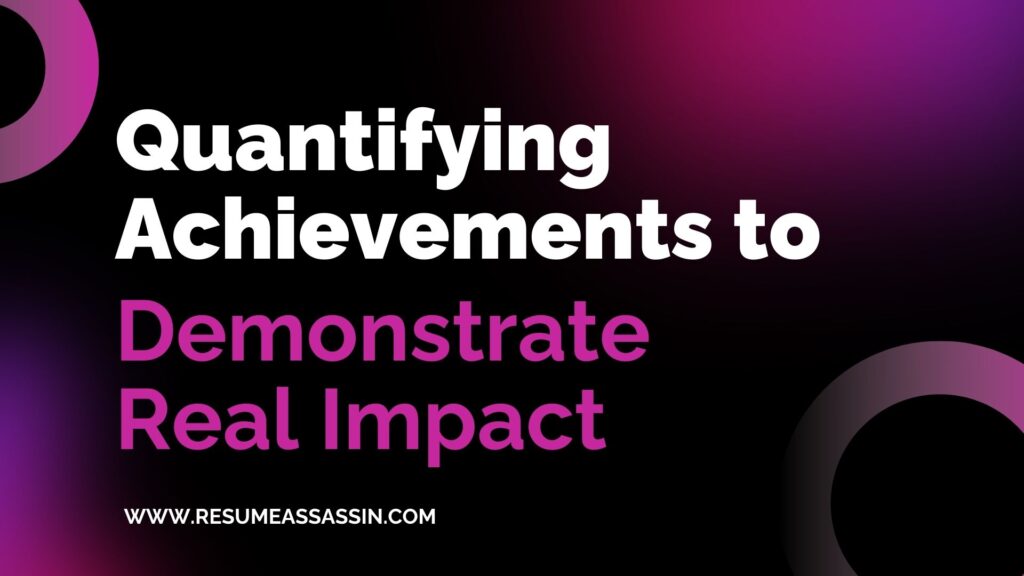
In today’s competitive tech job market, having a resume filled with impressive titles, responsibilities, and buzzwords isn’t enough. Recruiters and hiring managers are overwhelmed with applications from candidates who all “developed software,” “led teams,” or “managed systems.” So how do you make your resume rise above the noise?
The answer lies in one word: quantify.
Why Quantifying Your Achievements Matters
Technical roles are inherently results-driven. Whether you’re a software engineer, data analyst, IT specialist, or UX designer, the value you bring to a company isn’t just about what you did—it’s about the impact you made.
Think of it this way: If you were investing in a business, would you be more convinced by someone who says “we grew our user base,” or someone who says “we increased our monthly active users by 150% in six months”?
Quantified achievements provide context to your work, validate your contributions with concrete results, help hiring managers envision your potential, and build instant credibility without overselling. Without numbers, a resume becomes vague and generic. With numbers, it becomes a clear narrative of success and results.
Common Resume Pitfall: Listing Tasks Without Results
Let’s say you wrote:
“Developed backend APIs for e-commerce application.”
That tells the reader what you did, but not how well you did it or what changed because of your work.
Now compare that to:
“Developed RESTful APIs for e-commerce app, decreasing server load time by 40% and supporting a 3x increase in daily transactions.”
Now we understand the impact of your work—and it’s impressive.
What Can You Quantify?
Not every achievement has to involve million-dollar savings or dramatic increases in speed. Here are examples of what you can measure:
- Time saved: Automating manual tasks, reducing debugging hours, improving deployment speed.
- Money saved or generated: Cutting software costs, increasing sales via platform improvements.
- Efficiency improvements: Reducing page load times, optimizing memory usage, streamlining workflows.
- Team contributions: Managing people, collaborating with cross-functional teams.
- Customer or user impact: Boosting app ratings, improving user satisfaction, increasing retention.
- Growth: Gaining new users, launching successful products, increasing engagement.
How to Quantify Your Technical Work
Here’s a step-by-step process to get you started:
1. Reflect on Your Past Work
Think about the projects you’ve worked on, the problems you solved, and the outcomes you influenced.
2. Find the Numbers
Review reports, dashboards, or even email threads to recall the data. Reach out to team leads if needed.
3. Use the STAR Method
Structure your experiences using:
- Situation: What was the problem?
- Task: What were you responsible for?
- Action: What did you do?
- Result: What changed and by how much?
Examples: From Vague to Impactful
Instead of saying:
“Worked on system upgrades.”
Say:
“Upgraded legacy system, reducing downtime by 25% and improving internal user access speed by 40%.”
Instead of:
“Managed a team.”
Say:
“Managed a cross-functional team of 6 developers, delivering 3 client projects on schedule with 98% satisfaction.”
Instead of:
“Fixed bugs.”
Say:
“Resolved 20+ recurring bugs, improving application stability and reducing user-reported issues by 60%.”
Pro Tip: Use Strong Action Verbs + Numbers
Start each bullet point with verbs like:
- Optimized
- Led
- Reduced
- Streamlined
- Engineered
- Delivered
- Automated
- Scaled
Then add your results:
“Engineered a data pipeline that processed 1M+ records daily, reducing reporting time from 2 hours to 15 minutes.”
Where to Include Quantified Achievements
- Professional Experience: Every bullet point under each job title should reflect outcomes.
- Summary Section: Include a quick highlight of your biggest wins using numbers.
- Certifications/Projects: If you completed a course or personal project, mention metrics like app downloads, GitHub stars, or data processed.
Final Thoughts: Data Is Your Best Advocate
In technical careers, data drives decisions—and your resume should reflect that. You already work in a world where performance is measured, optimized, and analyzed. Apply that same thinking to your job search.
Quantifying your resume doesn’t just help you land interviews—it shows future employers that you understand what really matters: delivering results.
When in doubt, ask yourself:
“If I were the hiring manager, how would I know this person made a real difference?”
And then let the numbers do the talking.
Need help turning your experience into impactful, quantifiable bullet points? Reach out and let’s bring your resume to life.
